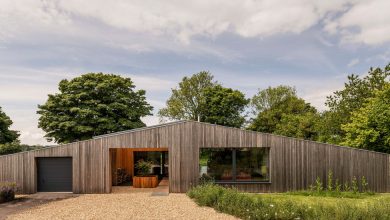As Buildings’ Life Spans Shrink, Developers Try to Adjust

[ad_1]
In 1931, glass bottles of sparkling soda began rolling off the assembly line at the Coca-Cola bottling plant in downtown Indianapolis. It’s unlikely that the factory’s architect gave much thought to the possibility that shifting consumer habits would make the glass bottle a relic within a couple of generations.
Instead of slipping into obsolescence, the factory went on to have multiple lives. After the Coke factory closed in 1971, the building was briefly used to house Indy 500 racecars, then spent decades as a school bus garage before becoming a 139-room boutique hotel anchoring a new entertainment district last year.
A century ago, developers didn’t give the future much thought, but today, they don’t have the same luxury. A combination of pandemic disruptions and constantly changing technology has brought the hazy, distant horizon much closer.
As a result, a growing number of projects are racing against the clock as profitability and utility are squeezed into the ever-shortening life of a commercial building. Statistics illustrating the acceleration of building life cycles are scarce, but experts in the industry are starting to take heed.
“The cycle of changing is becoming shorter,” said Jefferson Duarte, associate professor of real estate finance at Rice University. Projects that developers once could have collected rents on for half a century or more don’t allow that anymore.
“Twenty years ago, we didn’t think about it,” Professor Duarte said. There was just an assumption that an office building would still be functioning a century later.
Some still are. Few developers think the Empire State Building is going anywhere soon as it approaches its centennial at the end of the decade.
A premium spot or landmark status can overcome obsolescence: Areas like Midtown Manhattan or Chicago’s Magnificent Mile seem likely to remain coveted spots where short shelf life would not be an issue.
“You could build a barn in Midtown Manhattan and you’d fill it up, because that is such a prime location,” said John Gallander, an independent real estate consultant in Costa Mesa, Calif., who has overseen commercial development portfolios throughout his career.
Developers are thinking as much about the future as they are about the present, said Christopher R. King, president and chief executive of DPC, a commercial property developer based in Denver. DPC just opened a 250,000-square-foot office development in Phoenix and hopes to hold on to it for six to 10 years.
Mr. King echoed the concerns of many in the industry that the pandemic had accelerated trends that could shorten the lives of buildings. Consumer and worker needs are changing more quickly than they used to, driven by technology, shifting supply chains and expectations of greater amenities. Such rapid cycling has been common in retail and food service, but it is relatively new to commercial real estate.
This shortening shelf life has left architects, developers and investors in a conundrum: How do you build for today without becoming obsolete tomorrow?
“I think we are being forced to think about it now,” Mr. King said, adding that his firm is trying to peer into the future by looking at things as diverse as parking garages, office density and ventilation technology.
“Everybody in the industry is talking about it but sort of circling around it,” said Gilles Duranton, a real estate professor at the University of Pennsylvania’s Wharton School. “There are all sorts of questions, but few answers.”
The core problem is that commercial construction is an industry producing highly durable goods in a world that is asking for greater flexibility with changing tastes and economic conditions, Professor Duranton said.
He added that the industry would have to address the shortening life span through a blend of approaches, including modular elements and construction methods that would let buildings be disassembled or demolished easily.
“Sometimes the right thing will involve tearing things down and rebuilding from scratch,” Professor Duranton said.
The acceleration of the natural progression in office space is similar to what has been happening for decades with sports stadiums and malls, which reach the end of their lives much faster than in previous generations, said Mr. Gallander, the real estate consultant.
Developers, though, are in a bind. If they stock an office building with too many specific amenities, they run the risk that the latest technologies will quickly become outdated. (Fax-friendly offices of the 1980s and ’90s with numerous phone hookups come to mind.) But if they don’t include enough amenities, they take the chance that potential tenants might look elsewhere.
In some ways, the tenant can save the developer, Mr. Gallander said. During the rise of the internet in the late ’90s, for instance, developers weren’t ready to address the growing need for connectivity. But in many cases, tenants pushed ahead with redesigns (most leases allow for liberal office redesign) and additional amenities to meet the challenges of an increasingly wired world. And most law firms transformed the layouts of their offices to adapt to shifting technological needs. That may happen again, he said.
The shorter life spans of buildings may force developers to recoup their money faster by selling earlier than planned, Mr. Gallander said.
“You may be looking to hit the exit gate after three to five years instead of seven, 10, 15 years,” he said.
Raising rents is not an option, he said, because the higher cost could push tenants to lower-price alternatives. Developers may also explore other ways to recoup their investments faster by taking on partners.
At its peak in 1950, the Coca-Cola bottling plant in Indianapolis employed 250 workers and turned out two million fizz-filled bottles of Coke a week. Now, it is home to the Bottleworks Hotel, the center of a mixed-use development that opened in late 2020 with the hopes of rejuvenating a neighborhood.
The developer of the site, Hendricks Commercial Properties, said the pandemic had shown the value of diversification as a bulwark against shorter building life spans. No one could have predicted that a havoc-wreaking pandemic would make gathering places so unappealing, at least in the short term. But by having a mix of offices, retail, hotel and other uses, the risk for Hendricks is spread out. The Bottleworks development has an eight-screen movie theater, for instance, but also a tech incubator.
The move toward unloading properties quickly may be accelerating, said Gavin Thomas, vice president of development at the firm, but Hendricks is in it for the long game.
“Hendricks’s timeline is not a three- or 10-year-horizon,” he said. “It is much longer than that, and that changes the dynamic and criteria on return perspective.”
But the specter of unanticipated change will color future projects. “Going forward, I’ll be asking how much flexibility we have,” he said.
[ad_2]
Source link






